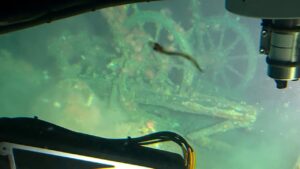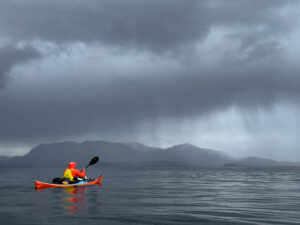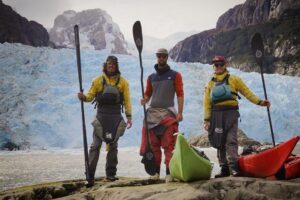In 2018, six young Canadians completed a 1,500km canoe journey through northern Quebec and Labrador. Three years later, they have set their sights on an even greater challenge. The core team will take on a 7,600km odyssey that will be the longest north-to-south crossing of Canada ever attempted.
Their journey involves three human-powered modes of transport and will take up to seven months. It begins at the Eureka weather station, two-thirds the way up Ellesmere Island, Canada’s northernmost island. From here, they will ski across sea ice for the first 1,600km, dragging sleds weighing 104kg and replenishing their supplies every 40 days or so.
Snaking south, a network of cold northern rivers and lakes will allow these skilled canoeists to paddle for another 2,000km. Finally, they will hop on bicycles to knock off the final 4,000km, finishing their expedition near the U.S. border, at Point Pelee National Park in southern Ontario, Canada’s southernmost point.

The 7,600km route. Photo: AKOR Expedition
Of the five team members, only Guillaume Moreau and Nicolas Roulx will attempt the whole expedition. Jacob Racine will join them for the initial skiing and Philippe Voghel-Robert and Etienne Desbois will canoe through Nunavut with them.
The expedition is missing out on a full north-to-south crossing by an easy 500km because the extra two-hour flight to Ellesmere’s Cape Aldrich, Canada’s northern tip, would have set them back an eye-watering $30,000.
To their credit, they did not take the decision lightly. Ultimately, they decided that the extra distance did not justify the cost. “I’m sure the 500km of skiing would be beautiful, but it does not change the expedition or alter that challenge. We are still undertaking the longest north to south human-powered crossing ever attempted,” Moreau explained.
They are also finishing the expedition informally, choosing to end at Point Pelee, near the Canada-U.S. border, rather than at nearby Middle Island, the true southernmost point of Canada.
Each segment of their journey brings different challenges. Sledding on the sea ice in mid-March, the coldest time of year, will be a tough workout, but the first real challenge may be the polar bears around southern Eureka Sound, near the beginning of their trek. This is a bear denning area, and the team will need to keep their wits about them. Fortunately, they have experience: Their 2018 expedition took them down the bear-dense Labrador coast.

Eureka Sound, between Ellesmere and Axel Heiberg Islands. Photo: Jerry Kobalenko
Moreau says they take the polar bear risk very seriously, though he notes that the density of polar bears in the High Arctic is much lower than on the north coast of Labrador. On that expedition, they maintained a bear watch at night, but they won’t follow the same tactic this time. Extreme cold will make such night shifts difficult for the watchman outside. Instead, they will rely on combined deterrents. They will set up a basic tripwire fence that fires flares and crackers if triggered.
But these fences are not infallible and can be set off by strong winds, so the team will also use motion-activated Margo Gadfly alarms. The final line of defense will be handheld flare guns equipped to fire bangers, flares, and screamers.

Polar bears were common during their 2018 Labrador expedition. Photo: AKOR Expedition
The main technical challenge of their entire route could be Lancaster Sound, just south of Resolute. This eastern end of the Northwest Passage features swift currents. Sometimes, the 70-kilometre-wide channel is open even at this time of year. Other times, moving pack ice makes progress dangerous and difficult. Occasionally, the channel is so solidly frozen that Inuit in Resolute snowmobile easily across it to hunt on Somerset Island. It’s a crapshoot, and they won’t know what to expect until they arrive in Resolute, 35 to 40 days after starting.
Likewise, the weather will dictate how difficult their 2,000km canoe journey will be. Moreau regards the early canoe sections as potentially extremely dangerous. If they are on schedule, Canada will be transitioning from winter to summer, and the team will be working upstream on major Barrenground rivers like the Back, Thelon, and Kazan during break up. Alternatively, if the ice disappears early, they would face just hard work poling and portaging upcurrent and paddling the lakes and quiet river stretches.

Ice can build up on the banks of northern rivers during the transition from winter to summer. Photo: AKOR Expedition
After Resolute, their next supply point is the hamlet of Gjoa Haven, on King William Island, central to both the tragic Franklin expedition and Roald Amundsen’s triumphant route through the Northwest Passage. After Gjoa Haven, they resupply at Baker Lake, where they begin the canoeing portion of the journey.
The expedition will continue the scientific work of their 2018 expedition. This involves sampling wood from Canada’s boreal forests to observe the effects of climate change. They are also conducting a separate study on how the human body adapts to extreme conditions.
The team will fly to the High Arctic in mid-March. Before their flight, they have to isolate in a special Ottawa hotel for two weeks as per Nunavut COVID regulations. COVID has further complicated their already laborious preparations. Travel is currently prohibited within Nunavut, but the expedition’s scientific work ensured that they were eventually given permission. Official confirmation came just two weeks ago, a long, nervy wait for an expedition three years in the making.
ExplorersWeb has had an indirect hand in the expedition, as editor Jerry Kobalenko has promoted that grand, undone idea for many years. The AKOR crew heard about it through Inuit kayaker Noah Noggasak, an old travel partner of Kobalenko’s, when they finished their 2018 expedition in Noggasak’s home town.
“A few years ago, I was dismayed to hear that Survivorman Les Stroud was planning to snowmobile that route in a couple of weeks,” said Kobalenko. “Fortunately, it didn’t come off. These Quebec guys are attempting it the right way, the hard way. It’s just a pity they’ll miss doing the entire route.”
ExplorersWeb will keep tabs on the expedition through regular updates.






